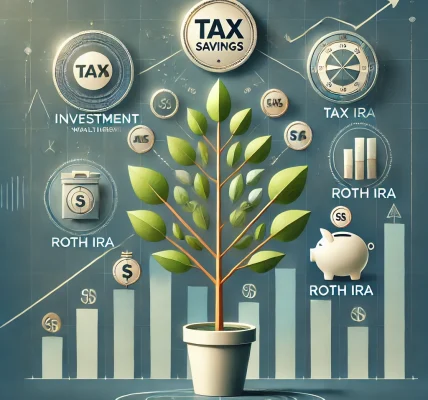When it comes to tax-saving instruments, the Public Provident Fund (PPF) stands out as one of the most popular and trusted choices among investors in India. Apart from offering attractive returns, it also provides significant tax benefits, making it a win-win for individuals looking to save both taxes and money for their future.
In this blog, we will explore how you can leverage PPF investments to save taxes, and how it can be a valuable addition to your overall financial plan.
1. What Is a Public Provident Fund (PPF)?
The Public Provident Fund (PPF) is a long-term savings scheme backed by the Government of India. It allows individuals to invest a portion of their income in a tax-efficient manner while providing a safe and secure avenue for wealth accumulation. PPF accounts are offered by banks and post offices, and they come with a minimum investment period of 15 years.
Key features of PPF:
- Interest Rate: The interest earned on PPF is tax-free and is set by the government every quarter.
- Lock-in Period: 15 years (with partial withdrawal allowed after 6 years).
- Investment Limit: Minimum ₹500 per year and a maximum of ₹1.5 lakh per year.
- Tax Benefits: The contributions made to PPF qualify for deductions under Section 80C of the Income Tax Act.
2. Tax Benefits of Investing in PPF
Investing in PPF offers several tax benefits, which can help reduce your overall tax liability. Let’s break down the key ways you can save taxes through PPF investments:
1. Tax Deduction Under Section 80C
The most significant tax benefit of PPF is its eligibility for tax deduction under Section 80C of the Income Tax Act. Any amount you invest in PPF up to ₹1.5 lakh per financial year qualifies for deduction from your taxable income.
For example, if your annual income is ₹10 lakh and you invest ₹1.5 lakh in your PPF account, your taxable income will be reduced to ₹8.5 lakh. This deduction helps lower your overall tax liability, reducing the taxes you have to pay to the government.
2. Tax-Free Interest and Maturity Proceeds
The interest earned on PPF investments is tax-free under Section 10(11) of the Income Tax Act. This means you do not have to pay any tax on the interest income generated by your PPF account, even though it accumulates over the years. Additionally, the maturity proceeds, which include the principal investment along with interest earned, are also exempt from tax.
This tax-free interest is a key reason why many investors prefer PPF over other taxable investment options like fixed deposits or bonds, where interest income is taxable.
3. Tax-Free Withdrawals
After the completion of the 15-year lock-in period, the entire balance in the PPF account, including both the principal and the accumulated interest, can be withdrawn without any tax liability. This makes it an excellent tool for long-term savings, as you can withdraw the amount when you need it and enjoy tax-free benefits.
Additionally, partial withdrawals are allowed from the 7th year onwards, subject to certain conditions. While the withdrawn amount is not taxable, the interest accrued on the withdrawn portion is not eligible for further tax exemptions.
4. PPF Contributions in HUF (Hindu Undivided Family)
Another tax-saving strategy with PPF is investing in the name of a Hindu Undivided Family (HUF). An HUF can also open a PPF account in the name of its members, and the investments made by the HUF qualify for a tax deduction under Section 80C. This allows you to claim an additional deduction of ₹1.5 lakh for the HUF, effectively doubling your tax-saving potential when compared to individual contributions.
3. Why PPF Is a Smart Tax-Saving Investment
While there are many tax-saving instruments available under Section 80C, the PPF stands out for several reasons:
1. Guaranteed Returns and Safety
Since PPF is a government-backed scheme, it is one of the safest investment options in India. The interest rate is revised quarterly but is always relatively stable compared to market-linked instruments like equities or mutual funds. This makes PPF a reliable long-term investment option for individuals who want security along with tax benefits.
2. Flexibility in Investment
You are not bound to contribute the maximum limit of ₹1.5 lakh every year. You can choose to invest a smaller amount if needed, with the minimum contribution being ₹500. The flexibility in investment amounts makes PPF suitable for individuals with varying income levels.
3. Long-Term Wealth Building
The 15-year lock-in period of PPF encourages long-term savings, which makes it ideal for building wealth over time. Given that the interest earned is tax-free, you can accumulate a significant corpus without worrying about taxes eroding your returns.
4. How to Open a PPF Account and Start Saving Taxes
Opening a PPF account is simple. You can open an account at any designated post office or authorized banks such as SBI, ICICI, HDFC, etc. All you need is the required documents, such as proof of identity, address, and PAN card.
Once the account is opened, you can start making contributions either through lump sums or regular monthly deposits. You can also set up an auto-debit facility for easy and consistent investing.
5. Conclusion: PPF as a Key Tool in Tax Planning
Public Provident Fund (PPF) is not just a safe and secure long-term investment, but it is also one of the most tax-efficient investment options available under Section 80C of the Income Tax Act. With its tax-free interest, tax deductions on contributions, and tax-free withdrawals, PPF provides a great way to reduce your taxable income and build a substantial retirement corpus over time.
By incorporating PPF into your financial plan, you can save taxes effectively while ensuring financial security for the future. Whether you’re planning for retirement or saving for your children’s education, PPF can be a valuable addition to your investment portfolio.




